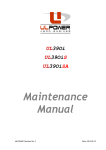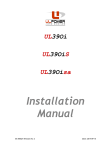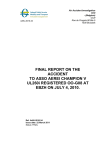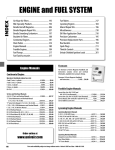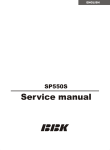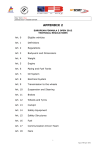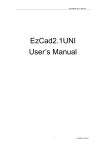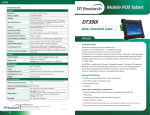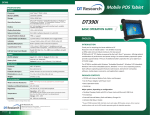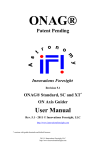Download ULPOWER UL390iSA Specifications
Transcript
UL39Oi UL39OiS UL39OiSA Operating Manual MO 390A01 Revision No: 2 Date: 2014-09-15 ULPOWER Operating Manual UL390i UL390iS UL390iSA Preface Thank you for deciding to use a ULPower engine. Before starting the engine, carefully read this manual. The Manual will provide you with basic information on the safe operation of the engine. If any passages of the manual are not completely understood or in case of questions, please contact a ULPower authorised representative. We hope you will have much pleasure and satisfaction flying your aircraft powered by a ULPower engine. Remarks The images in this manual show the typical construction. They may not represent in full detail or the exact shape of the parts which have the same or similar function. Specifications are given in the SI metric system with the USA equivalent in parenthesis. Where precise accuracy is not required, some conversions are rounded off for easier use. In addition to this Operating Manual, please refer to the following: Installation Manual Maintenance Manual Please make sure you have the latest version available of the applicable manual. Modifications The information and components/system descriptions contained in this Operating Manual are correct at the time of publication. ULPower, however, maintains a policy of continuous improvement of its products without imposing upon itself any obligation to install them on its products previously manufactured. ULPower reserves the right at any time to discontinue or change specifications, designs, features, models or equipment without incurring obligation. Engine serial number On all enquiries or spare parts orders, always indicate the engine serial number, as the manufacturer makes modifications to the engine for further development. Repeating symbols This manual uses the following symbols to emphasize particular information. These indications are important and must be respected. WARNING : Identifies an instruction which, if not followed, may cause serious injury including the possibility of death. Attention : Denotes an instruction which, if not followed, may severely damage the engine or other components. Note : Indicates supplementary information which may be needed to fully complete or understand an instruction. MO 390A01 Revision No: 2 Date: 2014-09-15 Page: 1 of 22 ULPOWER Operating Manual UL390i UL390iS UL390iSA Safety information The engine should only be installed and placed into operation by persons familiar with the use of the engine and informed with regard to possible hazards. Only ULPower authorized service centres are qualified to work on these engines. This engine is designed for possible application on aircraft used in VFR conditions which have the capabilities of controlled gliding without engine power. You should be aware that any engine may seize or stall at any time. This could lead to a crash landing and possible severe injury or death. For this reason, we recommend strict compliance with the maintenance and operation and any additional information which may be given to you by your dealer. Never fly the aircraft equipped with this engine at locations, airspeeds, altitudes, or other circumstances from which a successful no-power landing cannot be made, after sudden engine stoppage. This engine is not suited for acrobatics (inverted flight, etc.). It should be clear that the choice, selection and use of this particular engine on any aircraft is at the sole discretion and responsibility of the aircraft manufacturer, assembler and ULPower makes no warranty or representation on the suitability of its engine's particular aircraft. Furthermore, ULPower makes no warranty or representation of suitability with any other part, component or system which may be selected by manufacturer, assembler or user for aircraft application. owner/user. use on any this engine's the aircraft Never run the engine without a propeller or flywheel as this will inevitably cause engine damage and present a hazard of explosion. Propeller/flywheel and its attachment with a moment of inertia in excess of the specified value must not be used and releases engine manufacturer from any liability. Improper engine installation and use of unsuitable piping for fuel-, cooling- and lubrication system releases engine manufacturer from any liability. Unauthorized modifications of engine or aircraft will automatically exclude any liability of the manufacturer for direct, indirect and/or sequential damage. Spare parts must meet with the requirements defined by the engine manufacturer. This is only warranted by use of genuine ULPower spare parts and/or accessories. They are available at the authorized ULPower distribution- and service partners. The use of anything other than genuine ULPower spare parts and/or accessories will render any warranty relating to this engine null and void. Respect all government or local rules pertaining to flight operation in your flying area. Fly only when and where conditions, topography, and airspeeds are safest. Select and use proper and calibrated aircraft instrumentation. This instrumentation is not included with the basic ULPower engine. Before flight, ensure that all engine controls are operative. Make sure all controls can be reached in case of an emergency. Unless in a run up area, never run the engine with the propeller turning while on the ground. Do not operate engine if bystanders are close. In the interest of safety, the aircraft must not be left unattended while the engine is running. Keep an engine log and respect engine and aircraft maintenance schedules. Keep the engine in top operating condition at all times. Do not operate any aircraft which is not properly maintained or has engine operating irregularities which have not been corrected. MO 390A01 Revision No: 2 Date: 2014-09-15 Page: 2 of 22 Operating Manual ULPOWER UL390i UL390iS UL390iSA To eliminate possible injury or damage, ensure any loose equipment or tools are properly secured before starting the engine. When in storage protect the engine, fuel, lubrication, induction and exhaust system from contamination and exposure. Never operate the engine without sufficient quantities of lubricating oil and cooling air. Allow the engine to cool at idle for several minutes before turning off the engine. MO 390A01 Revision No: 2 Date: 2014-09-15 Page: 3 of 22 Operating Manual ULPOWER UL390i UL390iS UL390iSA Table of contents Preface ..................................................................................................................1 Remarks ............................................................................................................... 1 Modifications ......................................................................................................... 1 Engine serial number ............................................................................................... 1 Repeating symbols .................................................................................................. 1 Safety information ....................................................................................................2 Table of contents .....................................................................................................4 Engine description ....................................................................................................6 General Description ................................................................................................ 6 Specifications ........................................................................................................ 6 Description of basic standard engine and accessories ........................................................ 7 Engine views ...........................................................................................................8 Denomination of cylinders ..........................................................................................9 Description of systems ...............................................................................................9 Lubricant system .................................................................................................... 9 Fuel system .......................................................................................................... 9 Electronic Engine Management system ........................................................................ 10 Cooling system ..................................................................................................... 10 General operating limits .......................................................................................... 11 Speed ................................................................................................................ 11 Running in .......................................................................................................... 11 Performance (ISA) ................................................................................................. 11 Acceleration ....................................................................................................... 11 Oil pressure ........................................................................................................ 11 Oil level? ............................................................................................................ 11 Oil temperature ................................................................................................... 11 Cylinder head temperature ..................................................................................... 11 Manifold air temperature ........................................................................................ 12 Outside air temperature ......................................................................................... 12 Relative fuel pressure ............................................................................................ 12 Deviation from bank angle ...................................................................................... 12 Electrical power ................................................................................................... 12 Maintenance ......................................................................................................... 12 Engine performance ................................................................................................ 13 Performance graphs for standard conditions (ISA) .......................................................... 13 Performance graph for non-standard conditions ............................................................ 14 Operating media .................................................................................................... 15 Fuel .................................................................................................................. 15 Lubricants .......................................................................................................... 15 Standard operation ................................................................................................. 16 Daily/Pre-flight checks ........................................................................................... 16 Engine start ........................................................................................................ 16 Prior to take-off ................................................................................................... 17 Warming up period: ............................................................................................ 17 Idle speed:....................................................................................................... 17 Throttle response: ............................................................................................. 17 Ignition test: .................................................................................................... 17 Take-off ............................................................................................................. 17 Cruise ............................................................................................................... 17 MO 390A01 Revision No: 2 Date: 2014-09-15 Page: 4 of 22 Operating Manual ULPOWER UL390i UL390iS UL390iSA Engine shut-down ................................................................................................. 17 Engine storage ..................................................................................................... 18 Abnormal operation ................................................................................................ 19 Abnormal running on ignition check ........................................................................... 19 Sudden engine stop ............................................................................................... 19 Nearing maximum engine speed ............................................................................... 19 Exceeding of max. admissible cylinder head temperature ................................................ 19 Exceeding of max. admissible oil temperature .............................................................. 20 Oil pressure below minimum .................................................................................... 20 Exceeding of max. admissible oil pressure ................................................................... 20 Relative fuel pressure deviates from normal ................................................................ 20 Single CHT and/or EGT drop .................................................................................... 21 Knocking ............................................................................................................ 21 Low battery voltage .............................................................................................. 21 MO 390A01 Revision No: 2 Date: 2014-09-15 Page: 5 of 22 ULPOWER Operating Manual UL390i UL390iS UL390iSA Engine description General Description 4 stroke, 6 cylinder, horizontally opposed Electronic multipoint fuel injection (pressure and temperature compensated) Electronic spark ignition (variable timing) Electronic RPM limiter Direct propeller drive 5 bearing crankshaft with a 6th large thrust bearing (ball bearing type) Single central camshaft Push rods, Solid Tappets (no hydraulic compensation) and Over head valves Wet sump forced lubrication with integrated pressure regulator Ram air cooled cylinders and cylinder heads Integrated AC generator, external rectifier-regulator Electric starter Electric fuel pump and pressure regulator Specifications UL390i Displacement: 105.6 mm Stroke: 74 mm 8,16 : 1 Firing order: Direction of Rotation: Torque (ISA conditions): Power rating (ISA conditions): Basic standard engine weight: Clockwise – Pilot's view – Tractor configuration 320 Nm @ 2800 rpm 140 hp @ 3300 rpm (130 hp @ 2800 rpm) 370Nm @ 2800 rpm 160 hp @ 3300 rpm 160 hp @ 3200 rpm (145hp @ 2800 rpm) (145 hp @ 2800 rpm) 100 kg (including starter motor and alternator) 100 kg 50 Amp Oil capacity: MO 390A01 Revision No: 2 9,1:1 1–4–5–2–3-6 DC output: Fuel (unleaded): UL390iSA 3900 cc Bore: Compression Ratio: UL390iS 4L MOGAS with min. 95 octane rating or AVGAS ( 95 octa = 87Mon = 91AKI ) Date: 2014-09-15 MOGAS with min. 98 octane rating or AVGAS ( 98 Oct = 90MON = 94 AKI ) Page: 6 of 22 Operating Manual ULPOWER UL390i UL390iS UL390iSA Description of basic standard engine and accessories The basic standard engine assembly consists of the following: Engine assembly Injectors, fuel pressure regulator and spark plugs Intake manifold, throttle and air filter Electric starter motor Integrated AC generator Propeller flange In addition to the basic standard engine assembly, following external items are necessary accessories: ECU, ignition coils and electrical wiring Fuel pump, filters and fuel lines Exhaust system Cooling ducts for cylinders and cylinder heads Temperature and pressure sensors, wiring (and gauges) External rectifier-regulator Optional oil cooler and connections MO 390A01 Revision No: 2 Date: 2014-09-15 Page: 7 of 22 ULPOWER Operating Manual UL390i UL390iS UL390iSA Engine views (*) Dimension for standard prop flange l =55 Different prop flange are available MO 390A01 Revision No: 2 Date: 2014-09-15 Page: 8 of 22 Operating Manual ULPOWER UL390i UL390iS UL390iSA Denomination of cylinders Description of systems Lubricant system The oil is drawn from the wet sump through a coarse filter on the oil pickup tube to the oil pump. From the pressure side of the pump, the oil passes the oil cooler (optional) and oil filter, after which it enters the main oil gallery to flow to various points of lubrication in the engine. The surplus oil emerging from the points of lubrication accumulates back into the wet sump on the bottom of the engine. Note: The oil pump unit is equipped with an integrated pressure release valve limiting the pressure at cold starts or in the event of blocked oil lines. Note: A pressure sensor should be installed to measure the pressure in the oil gallery, while a temperature sensor should be installed to measure the oil temperature in the oil sump. Fuel system Fuel flows from the tank through a coarse filter to the electrical fuel pump. From the pressure side of the pump it passes through a fine filter, on to the injectors and integrated pressure regulator, after which it returns to the fuel tank and suction side of the fuel system. Note: The constant flow and pressure helps eliminate the possibility of a vapour lock within the fuel line circuit. Note: The fuel pressure regulator causes a 3 bar pressure difference between the pressure in the fuel lines and the varying pressure in the inlet manifold causing a constant pressure flow through the injectors. MO 390A01 Revision No: 2 Date: 2014-09-15 Page: 9 of 22 Operating Manual Note: ULPOWER UL390i UL390iS UL390iSA The fuel pressure sensor should measure the pressure in the fuel line between the electric fuel pump and the engine. Electronic Engine Management system The UL390i is equipped with an electronic injection and ignition system. RPM and Throttle Position are the main inputs to the ECU (Engine Control Unit). The pre-programmed fuel map in the ECU regulates the amount of fuel that is injected through the injectors and the pre-programmed advance map decides on ignition timing. On a signal of the ECU the ignition coils convert the incoming current of the alternator or battery into a high voltage current to generate a spark in the sparkplugs. Note: The injection system is pressure and temperature compensated and has an automatic choke function for cold starts. Note: Since the engine is managed electronically and a current is needed to generate the sparks and operate the fuel pump, the engine cannot run without a working electrical system. The engine and fuel pump use about 21 Amps (12V DC) to operate. Note: The engine comes with an integrated AC generator with external rectifier/regulator that can supply up to 50 Amps. This should be sufficient to charge the battery while the engine is operating and other electrical aircraft systems are in use. Cooling system The UL390i is an air cooled engine. Ram air ducts/chamber should guide(s) the incoming air sufficiently and equally over the cylinders and cylinder heads. Oil is cooled by fresh cool air flowing over the oil sump. Depending on flying conditions a supplementary oil cooler may be necessary and can be connected and placed in fresh airflow. Note: Cylinder head temperatures are measured by means of temperature probes inserted in the cylinder heads with a bayonet fitting or alternately with ring-probes positioned under the spark plugs on the exhaust side. MO 390A01 Revision No: 2 Date: 2014-09-15 Page: 10 of 22 ULPOWER Operating Manual UL390i UL390iS UL390iSA General operating limits Speed Max. engine speed ...................... Recommended prop speed ............ Normal idle speed ....................... Min. idle speed .......................... 3300 rpm 2400 - 2800 rpm 850 rpm 700 rpm Running in To run in a new engine, it is recommended to limit the speed at 3000 rpm for the first 5 hours. Performance (ISA) a) UL 390i Maximum (for 5 minutes) : 140 hp @ 3300 Rpm Maximum continuous power : 125 hp @ 2800 Rpm b) UL 390is Maximum (for 5 minutes) : 160 hp @ 3300 Rpm Maximum continuous power : 143 hp @ 2800 Rpm Acceleration Limit of engine operation at zero gravity and in negative "g" conditions Max. ....................................... 3 seconds at max. –0.5 g Oil pressure Max. ....................................... 8 bar (115.0 psi) (cold start) Normal .................................... 2–5 bar (30–75 psi) — above 2000 rpm Min. ........................................ 1 bar (14,5 psi) — below 2000 rpm/above 900 rpm Oil level? Max. ....................................... 4,0 litres (4,22 quarts) Min. ........................................ 3,0 litres (3,17 quarts) Oil temperature Max. ....................................... 120°C (248°F) Min. ........................................ 50°C (122°F) Normal .................................... 80-100°C (175-212°F) Cylinder head temperature Max. ....................................... 190°C (375°F) Max. continuous ......................... 160°C (320°F) Min. ........................................ 50°C (125°F) MO 390A01 Revision No: 2 Date: 2014-09-15 Page: 11 of 22 ULPOWER Operating Manual UL390i UL390iS UL390iSA Manifold air temperature Max. ....................................... 40°C (104°F) May not exceed outside air temperature Outside air temperature Max. ....................................... 65°C (150°F) Min. ........................................ -25°C (-15°F) Relative fuel pressure Relative fuel pressure is the difference between the pressure in the fuel line and the pressure in the intake manifold Max. ....................................... 3.8 bar (55 psi) Min. ........................................ 2.4 bar (35 psi) Normal .................................... 3 bar (43.5 psi) Deviation from bank angle Value to which the wet sump lubrication system warrants lubrication in positive "g" flight situation Max. ....................................... 30° Electrical power Min.: 12 VDC Be sure the battery is completely loaded before take off with an output voltage min = 12 VDC WARNING: Make sure operating limits are respected at all times. Running the engine outside of the limits set by the manufacturer may severely damage the engine and will render any warranty relating to this engine null and void. Maintenance Maintenance should be performed at regular intervals to keep the engine in top operating condition. Please refer to the last published Maintenance Manual of the engine for maintenance schedule. MO 390A01 Revision No: 2 Date: 2014-09-15 Page: 12 of 22 Operating Manual ULPOWER UL390i UL390iS UL390iSA Engine performance Performance graphs for standard conditions (ISA) The following graphs shows the performance of the UL390i The following graphs shows the performance of the UL390iS MO 390A01 Revision No: 2 Date: 2014-09-15 Page: 13 of 22 Operating Manual ULPOWER UL390i UL390iS UL390iSA Performance graph for non-standard conditions The following graph shows the calculated performance drop with increasing flight altitude. The curves show the performance at 3300, 2800, 2500 and 2200 rpm, at full throttle. UL390i: UL390iS: At deviation of temperature conditions from standard atmosphere conditions the engine performance to be expected can be calculated from the performance indicated, multiplied by standard temperature in °K, divided by actual temperature in °K. Pactual = Pstandard . ( Tstandard / Tactual ) T[°K] = t[°C] + 273.15 MO 390A01 Revision No: 2 Date: 2014-09-15 Page: 14 of 22 ULPOWER Operating Manual UL390i UL390iS UL390iSA Operating media Fuel UL390i Regular unleaded automotive fuel with a minimum of 95 octane RON (= 87 MON=91AKI) should be used to operate the engine. AVGAS 100 LL my be used if regular fuel is not available. Note: Due to higher lead content in AVGAS, the wear of the valve and valve seats, the deposits in combustion chamber and lead sentiments in the lubrication system will increase. UL390iS/UL390iSA Regular unleaded automotive fuel with a minimum of 98 octane RON(=90 MON=94AKI) should be used to operate the engine. AVGAS 100 LL may be used if regular fuel Is not available. Note: Due to higher lead content in AVGAS, the wear of the valve and valve seats, the deposits in combustion chamber and lead sentiments in the lubrication system will increase. Lubricants High quality full synthetic or semi synthetic multi grade oil should be used to guarantee the quality of lubrication on all moving and rotating parts of the engine. Note: We recommend the use of Motul 300V (15W50) oil or Aeroshell SAE15W50 oil as most of our engine testing has been done with these types with good results. Attention: Do not use special brake-in oils as these don't guarantee the same quality of lubrication to crankshaft, camshaft and tappets. Attention: Do not fill the oil sump with more than 4,0 litres (4,2 quarts) of oil as more could cause the oil to constantly be whipped by camshaft gear. The absolute minimum quantity in the oil sump (before take-off) should be 3,0 litres (3,2 quarts), so be sure to add sufficient oil to compensate the quantity of oil that remains in the oil cooler, -lines and -galleries. Attention: If AVGAS 100 LL is used frequently, we advise not to use full synthetic oil, as the oil does not handle the lead deposits as well. More frequent oil changes are also recommended. MO 390A01 Revision No: 2 Date: 2014-09-15 Page: 15 of 22 ULPOWER Operating Manual UL390i UL390iS UL390iSA Standard operation Daily/Pre-flight checks WARNING: Conduct checks on cold engines only as there could be a risk of burns and scalds! Turn the propeller by hand in the direction of engine rotation several times and observe engine for odd noises or excessive resistance and normal compression. If irregular, first check tappet adjustment. WARNING: Make sure ignition is turned OFF when inspecting the engine. Have the cockpit occupied by a competent person. Check that all spark plugs, leads and electrical connections are secure. Verify the free movement of the throttle cable over the complete range. Check from cockpit. Check for any oil and fuel leaks. Note: Fuel pump must have been switched on to ensure the fuel lines are under pressure. Check oil level and replenish as required. Note: The oil level should be between the min. and max. marks. Before long periods of operation ensure the level is at least up to mid position. Difference in oil quantity between min. and max. level is 0.8 litres. Inspect exhaust system for damage, leakage and general condition. WARNING: Do not release the engine into service before rectification of any possible problem found during the daily/pre-flight checks. Engine start WARNING: Do not start the engine if any person is near the aircraft. 1. Fuel tap ............................... OPEN 2. Master switch ......................... ON 3. ECU ..................................... ON 3. Ignition Coils .......................... ON 4. Fuel pump ............................. ON (if not connected to ECU steering relay) Attention: Pump fuel around for a few seconds before starting the engine to avoid vapour lock and ensure fresh fuel from the tank is available. 5. Throttle lever ........................ set to 10% position 6. Starter ................................. ENGAGE Attention: Activate starter for max. 5 seconds only (without interruption), followed by a cooling period of 15 seconds if restart is necessary. Do not engage starter as long as engine is turning. Wait until complete stop of engine. As soon as engine is running adjust throttle to achieve smooth running at approximately 1200 rpm. Check if oil pressure has risen within 5 seconds (if not: shut down). Verify pressure remains within the limits. Attention: Increase of engine speed is only permitted when oil pressure reading remain below maximum. Check fuel pressure (2.4 à 3.8 bar) MO 390A01 Revision No: 2 Date: 2014-09-15 Page: 16 of 22 ULPOWER Operating Manual UL390i UL390iS UL390iSA Prior to take-off Warming up period: Start warming up period with engine running between 1200 and 1500 rpm, duration depending on ambient temperature, until: oil temperature reaches at least 40°C (105°F) cylinder head temperatures are not less than 50°C (125°F) Attention: Always check temperatures and pressures are within limits. Idle speed: When warm, engine can be set at idle speed. Note: Although engine idle speeds of 700 rpm can be obtained, we recommend the ground idle to be at least 850 rpm for smooth running. Throttle response: When ready for take-off do a short full throttle ground test. No irregularities may occur. Note: Check with aircraft/propeller operating handbook, since engine speed depends on the propeller used. Ignition test: The engine is equipped with double redundant ignition. Switch off one ignition coil at the time and verify that engine remains operation normally on both ignition coils separately. RPM difference between running with coil 1, with coil 2 or both may not exceed 5% of nominal RPM. Take-off Climbing with the engine at maximum take-off power (3300 rpm @ full throttle) is permitted during a time period of max. 5 minutes. Depending on propeller setting take-off power at 2800 rpm @ full throttle is permitted with no time limitation. Attention: Observe that all temperatures and pressures remain within limits at all times. If CHT’s exceed maximum, reduce power. Cruise Set power as required. Attention: Respect operating limits at all times. Avoid operating with oil temperature below normal operation (80-100°C / 175-212°F), as low operating temperatures may not eliminate any accumulated water in the engine. The formation and presence of condensation water in the lubrication system badly influences the oil quality. Engine shut-down Shut down engine by switching off power to ECU before eventually cutting off fuel/ignition. Normally the cooling down of the engine during the descent and taxiing will be sufficient to allow the engine being shut-down (by switching the ignition off) as soon as the aircraft has stopped. MO 390A01 Revision No: 2 Date: 2014-09-15 Page: 17 of 22 Operating Manual Note: ULPOWER UL390i UL390iS UL390iSA If temperatures are still at the high end of the limits, permit the engine to cool down by idling the engine for a few minutes before shut-down. Engine storage For long out of service periods we recommend the following to protect the engine against corrosion. - Let engine run until warm, then change oil - Remove the air inlet filter and insert approx 30 cm3 (1 Fl oz) of corrosion inhibiting oil into the inlet collector with the engine running at increased idle speed - Shut off engine - Close all openings on the cold engine, like exhaust end pipe, air intake (throttle), venting tube. - Spray all steel external engine pars with corrosion inhibiting oil - Store the engine as dry as possible MO 390A01 Revision No: 2 Date: 2014-09-15 Page: 18 of 22 ULPOWER Operating Manual UL390i UL390iS UL390iSA Abnormal operation WARNING: At unusual engine behaviour, follow the guidelines below and perform the necessary maintenance and/or checks before next flight. All problems and carried out maintenance/repairs/replacements should be noted in the engine logbook. Abnormal running on ignition check When one ignition coil is switched off and the engine runs differently than with both coils switched on, there are multiple causes possible. Depending on the amount of cylinders that stop firing verify/replace the following corresponding to the ignition coil that was not switched off: one cylinder: check ignition lead and sparkplug of the corresponding cylinder and coil. two cylinders: check ignition coil, it's connection or wiring loom from ECU to the coil. all cylinders: check ignition coil, it's connection or wiring loom from ECU to the coil. Attention: Engine needs only one ignition system to function properly. The second system is used as an emergency backup. Operating the engine on one ignition system only reduces redundancy/safety, not the power output. Sudden engine stop WARNING: If prior to sudden engine stoppage no abnormal noise indicated internal damage to the engine, try to restart the engine, otherwise conduct power-off emergency landing. Before restarting the engine, check the following: sufficient fuel level open fuel tap master and ignition switch on fuel pump switched on fuel pressure electrical system working sufficient battery voltage (eventually switch off all non-necessary electrical consumers) In the event the engine did not restart, or abnormal noise indicated possible internal damage to the engine, perform the daily/pre-flight checks (as stated before) carefully to pinpoint the problem. Check fuel for eventual contamination. Rectify the problem if possible or send the engine for inspection/overhaul to a ULPower authorised service-centre. Any sudden engine stop should be entered into the logbook, stating the possible reason. Nearing maximum engine speed Engine is equipped with an electronic rpm limiter. When reaching maximum engine rpm, the engine will seem to hold back and slightly sputter. Throttle back to reduce engine speed. Exceeding of max. admissible cylinder head temperature Reduce engine power setting to the minimum necessary and verify that CHT drops. Continue normal flight within the temperature limits. WARNING: If temperature does not drop, carry out emergency/precautionary landing. Any exceeding of the max. admissible CHT has to be entered by the pilot into the logbook, stating duration and extent of over-temperature condition. MO 390A01 Revision No: 2 Date: 2014-09-15 Page: 19 of 22 ULPOWER Operating Manual UL390i UL390iS UL390iSA On the ground, verify that cooling ducts are still in place and air is free to flow over and through cylinder head cooling fins. If problem remains, the engine should be sent for inspection/overhaul to a ULPower authorised service-centre. Exceeding of max. admissible oil temperature Reduce engine power setting to the minimum necessary and verify that oil temperature drops. Continue normal flight within temperature limits. WARNING: If temperature does not drop, carry out emergency/precautionary landing. Any exceeding of the max. admissible oil temperature has to be entered by the pilot into the logbook, stating duration and extent of over-temperature condition. On the ground, verify that oil level is sufficient and air is free to flow through oil cooler. If problem remains, the engine should be sent for inspection/overhaul to a ULPower authorised service-centre. Oil pressure below minimum WARNING: Oil pressure should be above minimum at all times. If not, the engine should be stopped immediately or as soon as possible. In flight, reduce engine power setting and speed to the minimum necessary and carry out emergency/precautionary landing. Any exceeding of the oil pressure under the minimum oil pressure has to be entered by the pilot into the logbook, stating duration and extent of under-pressure condition. On the ground, verify that oil level is sufficient and that no oil leaks are present. Check that oil lines to and from the oil cooler are not twisted/blocked or leaking. If oil cooler and oil lines are not blocked, oil filter should be inspected and changed. If problem remains, the engine should be sent for inspection/overhaul to a ULPower authorised service-centre. Exceeding of max. admissible oil pressure WARNING: Note: Oil pressure should be below the maximum at all times. If not, the engine should be stopped immediately or as soon as possible. At cold start, the oil pressure could be higher for several minutes as the oil is still cold and not as liquid, resulting in a higher pressure. Nevertheless, the maximum pressures of both warm and cold engines should not be exceeded as it indicates a problem with the pressure relief valve or oil lines/galleries and thus no/improper lubrication. Any exceeding of the max. admissible oil pressure has to be entered by the pilot into the logbook, stating duration and extent of over-pressure condition. On the ground, verify the oil level. Check pressure relief valve. If problem remains, the engine should be sent to a ULPower authorised service-centre for inspection/overhaul. Relative fuel pressure deviates from normal WARNING: Note: Verify that fuel level and battery voltage are sufficient (min 12 VDC), and that the electrical system is working properly. If battery voltage is running low, switch off unnecessary electrical consumers. Carry out emergency/precautionary landing. A change in relative fuel pressure influences the air-fuel mixture. If pressure drops, the mixture becomes too lean; if pressure rises, the mixture becomes to rich. Any deviation in the correct air-fuel ratio can influence the power output of the engine. Attention: A too lean fuel mixture can cause knocking, and severe damage to the engine. While the engine is not running (ignition off, but master switch and fuel pump on) the same problems should show. MO 390A01 Revision No: 2 Date: 2014-09-15 Page: 20 of 22 ULPOWER Operating Manual UL390i UL390iS UL390iSA On the ground, check fuel or electrical system for possible cause. Replace filter(s), pump(s), lines, pressure regulator or sensor as necessary. Test the fuel system with ignition off and master switch and fuel pump on. Single CHT and/or EGT drop Verify that both CHT and EGT of the same cylinder have dropped. If not, CHT or EGT probe or signal intake have a malfunction. Correct before next flight. WARNING: A large deviation of both CHT and EGT temperatures in one cylinder, when compared to the others, indicates that the particular cylinder is not firing properly or is not firing at all. Engine delivers reduced power. Carry out emergency/precautionary landing. If it is not a sensor malfunction, send the engine to a ULPower authorised service-centre for inspection/overhaul. Knocking Reduce engine power setting to the minimum necessary and keep engine temperatures well below the maximum. WARNING: Carry out emergency/precautionary landing. Be sure the right fuel type and octane rating have been used. Low battery voltage Switch off all unnecessary electrical consumers, as engine needs battery to operate. WARNING: Carry out emergency/precautionary landing. To reduce electrical power consumption in flight even more, one ignition system can be turned off. Keep in mind that ignition backup system is not operating at that time, but in the event of an emergency, can be manually selected by switching second ignition system back on and switching first off. On the ground, have generator, battery and electrical systems checked for any malfunction. Verify that no more than 15 Amps are being used by electrical devices other than the engine and fuel pump. MO 390A01 Revision No: 2 Date: 2014-09-15 Page: 21 of 22























